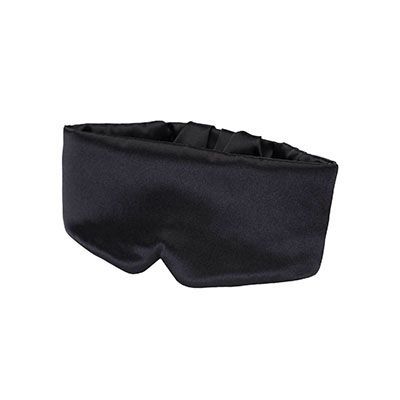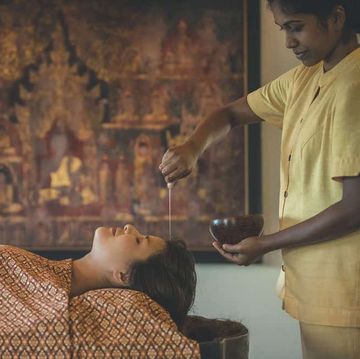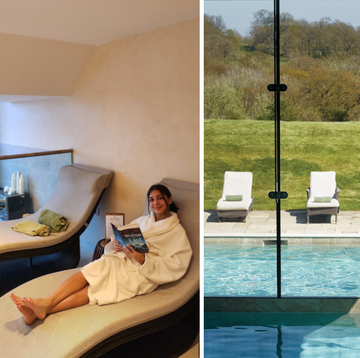Sleep proving elusive, even when you've parked your phone, done your 'yoga for bedtime' session with Adrienne and drawn yourself a hot, magnesium salt-packed bath?
If so, know that you are far from alone: according to the latest data released by the NHS, one third of UK adults will experience spells of insomnia at some point. When work, family and political stresses collide, it's little wonder.
One thing it pays to try? Breathing techniques for sleep.
One person who encourages working with your breath to catch more zeds is Michael Townsend Williams, a yoga and mindfulness teacher, author of Do Breathe (£8.99, thedobook.co) and co-founder of the app BreatheSync, which helps you breathe in sync with your heart to reduce stress and improve focus.
'Sleep problems are often caused by our inability to switch off the mind and relax our bodies, which is where breathing can help,' he tells WH. 'Slow, controlled breathing triggers the body’s natural relaxation response. Your heart rate slows, your muscles relax and your mind calms down, making you more mentally and physically prepared to fall asleep easily.'
So, rather than rattling through your to-do list or over-analysing the day’s conversations as you attempt to slumber, why not turn your attention to your breathing instead. Close your eyes (or pop on one of the sleep masks below) and learn how you can use breath as a relaxation technique.
5 breathing techniques for sleep to try
1. Best breathing technique for anxiety
When you’re suffering from the symptoms of anxiety and can’t stop worrying, simply counting your breaths can slow down your mental chatter, prevent the escalation of worry and help you reach a calm, centred place.
How to deal with anxiety can be as simple as breath work. Michael recommends:
- Counting your breaths down from 40.
- To start with, count both your exhalations and inhalations from 40 to 20.
- Then, from 20 to 0, count only your exhalations.
- After that, continue to breath normally but with awareness of your breath.
If you find this hard, then it’s fine to start the technique with lower numbers. The important thing is that you’re training your mind to focus where you want it to be, not on endless worries. If you’re still feeling anxious or struggling with anxiety attacks, then try writing your concerns down and then repeating the breathing exercise.
2. Best breathing technique for stress
While anxiety often encompasses a generalised and wide-ranging sense of worry, stress is normally related to a specific event or area of your life, such as a work assignment or upcoming speech.
Whilst managing your stress is important, Michael points out that experiencing it isn’t always a bad thing. 'If you’re stressed because you’re facing a new challenge at work or moving out of your comfort zone, don’t worry. It’s normal to feel pressure in these situations. But to perform at your best you need to feel calm and energised, and that won’t happen if you don’t get a good night’s sleep.'
One technique that might help is simple alternate nostril breathing. How?
- Close your right nostril and breathe in through the left.
- Then, close the left and breathe out through the right.
- Breathe in right. Breathe out left.
- Continue breathing slowly and deeply from one side to the other.
Hopefully, this should make you feel calm and focused. Close your eyes, visualise yourself successfully completing whatever challenge you’re stressed about, then let yourself relax into sleep.
3. Best breathing technique for over-thinking
We’ve all done it - got into a heightened state before bed by watching an intense drama on the TV or scrolling for hours on a smartphone. This type of activity puts the sympathetic branch of your autonomic nervous system into overdrive. As a result, stress hormones adrenalin and cortisol in your blood make it difficult to switch off your over-stimulated mind and tense body, and sleep is tricky.
In this instance, Michael recommends breathing from your belly. Try:
- Breathe in for four seconds and out for six seconds, both through the nose.
- This will equal six full breaths a minute, which research has shown to be the best rhythm for improving your physiology effectively.
A longer exhalation like this triggers the relaxation response. In a short time your body will be free of adrenalin and cortisol and you will feel a lot better for it.
4. Best breathing technique for insomnia
It’s hugely irritating when you wake in the middle of the night and can’t get back to sleep (we've all ended up in the 'how to sleep better' Google hole once). Michael recommends an exercise from his mindfulness course to combat this, in which you imagine drawing a line slowly around your body.
How?
- Start from the crown of you head.
- Make your way down the right side of your body, around your arms and legs.
- Then go back up the left side of your body, ending up where you started.
- Keep your mind occupied with this ‘body trace’ while breathing slowly and deeply from your belly.
Another option is to simply notice the gaps between your breaths. Observe how when your breath stills for a moment, your mind naturally stills too. Sometimes these little pauses are all it takes to learn how to get a good night's sleep.
5. Best breathing technique for energy
While many people struggle to get to sleep, others have the opposite problem, feeling sleepy even in the morning or during the day when they need to be awake.
In this case, Michael recommends a classic yoga exercise. Kapalabhati (literal meaning: shining skull) are rhythmic exhalations with a pumping action that flush out air from your lungs, stimulate the nervous system and release tension.
To prepare, take three deep breaths in and out. Then:
- Draw your tummy in sharply as you exhale. Repeat once a second so you get into a rhythm.
- Remember not to hold your breath; you will be inhaling in between exhalations but not consciously. Just focus on the sharp exhalations.
- If you find this difficult, try placing your hand on your tummy and press gently with each exhalation. It can take time for your stomach muscles to react quickly enough.
- Repeat with 20 pumps at first, then breathe deeply before holding your breath for 30 seconds if possible.
That’s one round done – you’re aiming to repeat for three rounds. You can build up the repetitions from 20 to 30 to 40 to 60. You can also learn to retain your breath for longer. Don’t be too competitive though – slow, steady progress is best.
















